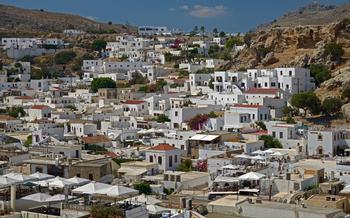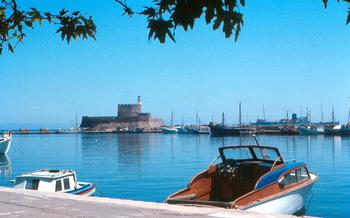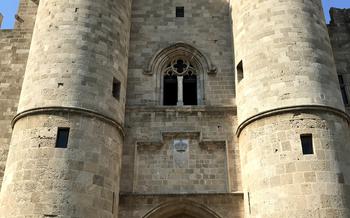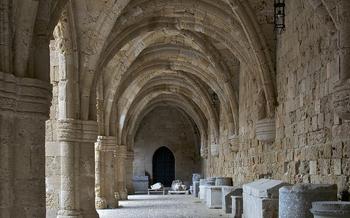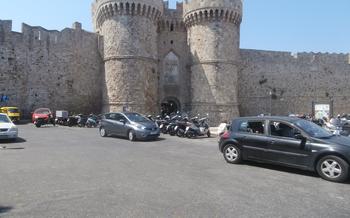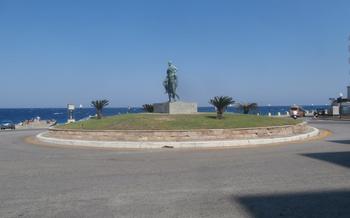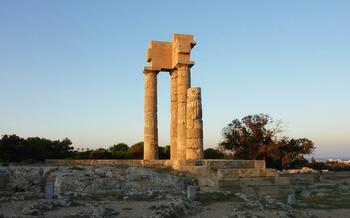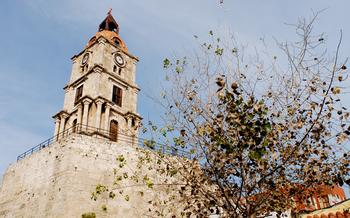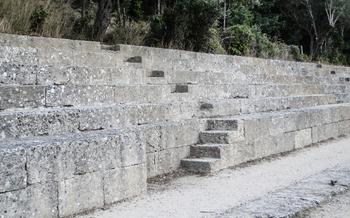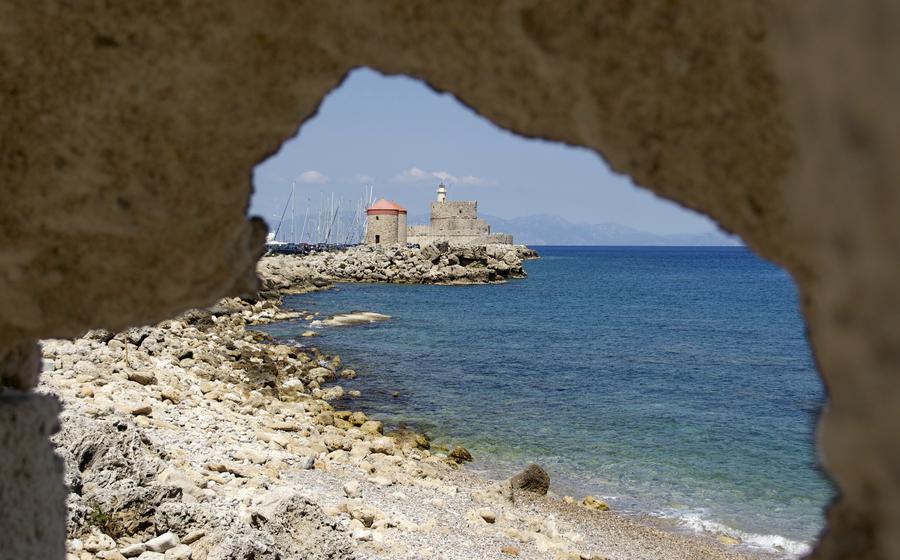
The Walls of Rhodes
- The Gates of Rhodes: Gateways to the Past
- The Sea Gate: A Maritime Masterpiece
- The Knights' Palace: A Symbol of Power and Prestige
- Architectural Highlights and Notable Features
- The Role of the Palace During the Knights' Rule
- Interesting Anecdotes and Stories Related to the Palace
- Street of the Knights: A Walk Through History
- The Palace of the Grand Master: A Majestic Residence
- The Archaeological Museum of Rhodes: A Treasure Trove of Ancient Artifacts
- The Acropolis of Rhodes: A Majestic Hilltop Citadel
- The Temple of Apollo: A Sacred Sanctuary
- The Ancient Stadium of Rhodes: A Place of Athletic Endeavors
- The Butterfly Valley: A Natural Paradise
- Faliraki Water Park: A Thrilling Adventure for All Ages
- Insider Tip: Unveiling Hidden Gems
The Gates of Rhodes: Gateways to the Past
The Walls of Rhodes are not just a single, monolithic structure, but a complex network of fortifications, towers, and gates that allowed access to the city. Each gate tells a unique story, reflecting the rich history of Rhodes.
The Marine Gate, facing the sea, served as the main entrance to the city. It was heavily fortified, with a drawbridge and a portcullis, to protect against naval attacks. The Gate of St. Catherine, on the eastern side of the walls, was named after the nearby church and served as a gateway for trade and commerce. The Gate of the Arsenal, near the harbor, provided access to the naval shipyard, where ships were built and repaired.
Each gate has its own architectural details and unique features. The Gate of St. Anthony, for example, features a beautiful marble relief depicting the coat of arms of the Grand Master. The Gate of the Seven Springs, on the western side of the walls, leads to the picturesque valley of the same name.
Exploring the gates of the Walls of Rhodes is like stepping back in time. They offer a glimpse into the past, when Rhodes was a bustling port city, a strategic military stronghold, and a cultural melting pot.
The Sea Gate: A Maritime Masterpiece
The Sea Gate, also known as the Marine Gate, stands as a testament to the ingenuity and defensive prowess of the Knights of St. John. Constructed in the 15th century, this imposing gateway served as the main entrance to the fortified harbor of Rhodes. Its strategic location allowed the knights to control access to the city and protect their maritime trade routes.
The Sea Gate is a marvel of medieval architecture, showcasing intricate carvings, imposing towers, and a massive portcullis. Its two round towers, known as the Towers of St. John and St. Paul, flank the gate and were designed to provide a formidable defense against potential invaders. The gate's thick walls, adorned with decorative arches and machicolations, further enhanced its defensive capabilities.
Beyond its military significance, the Sea Gate also played a crucial role in the economic prosperity of Rhodes. The harbor served as a bustling hub for trade and commerce, with ships from across the Mediterranean Sea docking at its quays. The gate's strategic position allowed the knights to regulate the flow of goods and collect customs duties, contributing to the city's wealth and prosperity.
Stories and legends abound surrounding the Sea Gate. One tale recounts the heroic defense of the gate by a single knight, who held off an entire invading force until reinforcements arrived. Another legend speaks of a hidden treasure buried beneath the gate, waiting to be discovered by a worthy adventurer.
Today, the Sea Gate stands as a proud symbol of Rhodes' rich history and maritime heritage. Visitors can explore its imposing fortifications, marvel at its architectural details, and imagine the epic battles that once took place within its walls.
The Knights' Palace: A Symbol of Power and Prestige
A magnificent edifice that stands as a testament to the Knights' reign over Rhodes, the Knights' Palace is a must-visit attraction for anyone seeking to delve into the island's rich history. Built in the 14th century, this imposing structure served as the official residence of the Grand Master, the leader of the Knights of St. John.
Architectural Highlights and Notable Features
The Knights' Palace is an architectural masterpiece that blends Gothic and Renaissance elements to create a striking visual spectacle. Its grand facade features intricate carvings and decorative elements, while the interior boasts a series of opulent halls and chambers that served various functions during the Knights' rule. The palace also houses an impressive collection of artifacts, including furniture, tapestries, and paintings that provide a glimpse into the lavish lifestyle of the Knights.
The Role of the Palace During the Knights' Rule
The Knights' Palace was not merely a luxurious residence; it served as the administrative and political center of the Knights of St. John. Within its walls, important decisions were made, strategies were devised, and alliances were forged. The palace was also a symbol of the Knights' power and authority, and its presence served to reinforce their dominance over the island.
Interesting Anecdotes and Stories Related to the Palace
The Knights' Palace has witnessed numerous significant events and played a role in many fascinating stories throughout its history. One such tale involves the daring escape of Grand Master Villiers de L'Isle-Adam during the Ottoman siege of Rhodes in 152Disguised as a humble monk, he managed to slip through the enemy lines and eventually reached safety in Crete.
Another intriguing story associated with the palace is that of the "Ghost of the Grand Master." According to legend, the spirit of a former Grand Master, known for his cruelty and greed, haunts the halls of the palace, seeking redemption for his past misdeeds. Visitors to the palace often report strange noises and eerie sensations, adding to its mystique and allure.
Street of the Knights: A Walk Through History
The Street of the Knights, known locally as Ippoton, is a captivating historical artery that runs through the heart of the Old Town of Rhodes. Its cobblestone surface and imposing medieval buildings transport visitors back to the days of the Knights Hospitaller, who ruled the island from the 14th to the 16th century.
Strolling along this picturesque street, visitors can admire the impressive facades and intricate details of the buildings that once housed the knights of different nationalities. Each building is adorned with unique emblems and coats of arms, representing the diverse origins of the knights who resided here.
During the Knights' rule, the Street of the Knights served as a bustling hub of activity. It was a place where knights gathered, held meetings, and conducted official business. The street was also lined with shops, inns, and taverns, creating a vibrant and cosmopolitan atmosphere.
Today, the Street of the Knights is a popular tourist attraction, offering a glimpse into the rich history of Rhodes. Visitors can explore the various buildings, which now house museums, art galleries, and shops selling traditional souvenirs and local delicacies.
Strolling along the Street of the Knights is a captivating experience that combines history, culture, and architectural beauty. It's a must-visit for anyone interested in exploring the legacy of the Knights of Rhodes and immersing themselves in the charm of this medieval city.
The Palace of the Grand Master: A Majestic Residence
The Palace of the Grand Master, a majestic edifice that once housed the leaders of the Knights of St. John, stands as a testament to the grandeur and power of the Order. Built in the 14th century, this impressive structure boasts an array of architectural wonders, including intricate carvings, vaulted ceilings, and elegant courtyards. Highlights of the palace include the Throne Room, where the Grand Master conducted official business, and the Grand Master's Hall, where lavish banquets and ceremonies were held. The palace's rich history is brought to life through captivating stories of the Knights' rule, their battles, and their legacy on the island.
The Archaeological Museum of Rhodes: A Treasure Trove of Ancient Artifacts
Housed in a splendid neoclassical building in the heart of the Old Town, the Archaeological Museum of Rhodes is a treasure trove of ancient artifacts that narrate the rich history and culture of the island. Its collection spans from the Neolithic era to the Late Roman period, offering a comprehensive glimpse into the civilization that flourished here.
Among the highlights of the museum are the impressive statues of Aphrodite, the goddess of beauty and love, and Zeus, the king of the gods. These majestic sculptures, crafted from gleaming marble, showcase the exquisite artistry of the ancient Rhodians. Equally captivating are the intricate mosaics that adorn the floors of the museum, depicting scenes from mythology, history, and everyday life.
The museum also boasts an impressive collection of pottery, jewelry, coins, and tools, each piece meticulously crafted and offering insights into the daily lives of the ancient inhabitants of Rhodes. Visitors can trace the evolution of pottery styles, from the simple geometric designs of the early periods to the elaborate figurative scenes of the Hellenistic era.
A visit to the Archaeological Museum of Rhodes is a journey through time, where visitors can immerse themselves in the rich cultural heritage of the island and gain a deeper understanding of its ancient past. The museum's well-curated exhibits, informative displays, and knowledgeable staff make it an essential destination for anyone interested in the history and archaeology of Rhodes.
The Acropolis of Rhodes: A Majestic Hilltop Citadel
Atop the ancient city of Rhodes, the Acropolis stands as a testament to the island's rich history and architectural prowess. Perched on Monte Smith, the highest hill in the city, the Acropolis offers breathtaking panoramic views of the surrounding landscape, including the sparkling Aegean Sea and the distant Turkish coast.
The history of the Acropolis dates back to the 4th century BC when the city of Rhodes was founded by the union of three ancient Greek settlements. The Acropolis served as the religious and administrative center of the city, housing significant temples, government buildings, and fortifications. The most prominent structure on the Acropolis is the Temple of Apollo, dedicated to the patron deity of Rhodes.
Exploring the Acropolis is like stepping back in time. The well-preserved ruins allow visitors to glimpse into the grandeur of ancient Rhodes. Admire the remnants of the Temple of Apollo, with its imposing columns and intricate carvings, and imagine the religious ceremonies that once took place within its walls. Walk along the ancient streets, lined with the foundations of houses and shops, and envision the bustling life of the city centuries ago.
The Acropolis also boasts impressive fortifications, a testament to the city's strategic importance. The sturdy walls, towers, and gates provided protection against invaders, and the strategic location of the Acropolis allowed for effective surveillance of the surrounding area.
As you wander through the Acropolis, let your imagination soar as you picture the ancient Greeks going about their daily lives, worshipping their gods, conducting business, and defending their city. The Acropolis of Rhodes is a place where history comes alive, inviting you to immerse yourself in the grandeur of the past.
The Temple of Apollo: A Sacred Sanctuary
A journey through time leads us to the Temple of Apollo, a sacred sanctuary that once stood as a beacon of worship and devotion to the divine. Built in the 3rd century BC, this magnificent structure was dedicated to Apollo, the Greek god of music, prophecy, and healing. Situated at the heart of the ancient city of Rhodes, the temple served as a spiritual and cultural center for the Rhodians, drawing pilgrims and visitors from far and wide.
Its architectural splendor was a testament to the skill and artistry of the ancient Greeks. The temple featured a majestic Doric façade, adorned with intricate carvings and sculptures that depicted scenes from Greek mythology. Inside, the sanctuary housed a colossal statue of Apollo, crafted from ivory and gold, which was revered as one of the Seven Wonders of the Ancient World.
The Temple of Apollo played a pivotal role in the religious life of the Rhodians. Here, they gathered to worship Apollo, offer sacrifices, and seek his guidance and protection. The temple was also an important site for festivals and celebrations, such as the Pythian Games, which honored Apollo with athletic competitions, musical performances, and artistic displays.
As the centuries passed, the temple underwent several renovations and modifications, reflecting the changing political and cultural landscape of Rhodes. During the Roman period, the temple was transformed into a church, while under Ottoman rule, it was converted into a mosque. Despite these changes, the sacred essence of the Temple of Apollo endured, leaving an indelible mark on the island's history and identity.
Today, visitors can explore the ruins of the Temple of Apollo, which stand as a testament to the grandeur and devotion of the ancient Rhodians. While the temple may no longer be a place of active worship, its spiritual legacy continues to inspire and fascinate those who seek to connect with the island's rich past.
The Ancient Stadium of Rhodes: A Place of Athletic Endeavors
Nestled amidst the ruins of the ancient city of Rhodes, the Ancient Stadium stands as a testament to the island's rich sporting heritage. Built in the 3rd century BC, this magnificent structure once hosted athletic competitions and chariot races, drawing spectators from across the ancient world.
With a capacity of over 8,000 spectators, the stadium was a marvel of engineering and design. Its stepped seating, carved from solid rock, provided excellent views of the events below. The starting line, still visible today, can transport visitors back in time to imagine the excitement and rivalry of ancient sporting competitions.
Beyond its sporting significance, the stadium also served as a venue for public assemblies and festivals. Here, citizens gathered to discuss important issues, celebrate victories, and honor their gods. The stadium's impressive acoustics ensured that even the most distant spectator could hear the speeches and proclamations.
Today, the Ancient Stadium of Rhodes stands as a reminder of the island's glorious past. Visitors can wander through the ruins, marveling at the architectural prowess of the ancient Greeks and imagining the vibrant atmosphere of sporting events and public gatherings.
The Butterfly Valley: A Natural Paradise
In the heart of Rhodes, nestled amidst a verdant landscape, lies the enchanting Butterfly Valley, a sanctuary for a myriad of vibrant and graceful winged creatures. Step into this natural paradise and embark on a journey of discovery, surrounded by a kaleidoscope of colors and delicate fluttering wings.
Home to over 1,000 species of butterflies, the valley is a haven for entomologists and nature enthusiasts alike. Stroll along the winding paths that meander through the lush vegetation, where butterflies of every hue dance in the sunlight. Admire the intricate patterns and vibrant colors that adorn their wings, each one a masterpiece of nature's artistry.
The valley's unique microclimate, with its abundant water sources and diverse vegetation, provides an ideal habitat for these delicate creatures. As you wander through this enchanting realm, you'll encounter clouds of butterflies fluttering around you, creating a magical and unforgettable experience.
Take a moment to pause and observe the intricate dance of the butterflies as they flit from flower to flower, sipping nectar and pollinating the surrounding plants. Their graceful movements and synchronized flight patterns are a testament to the wonders of nature's choreography.
Remember to tread lightly and respect the delicate ecosystem of the valley. Avoid disturbing the butterflies and refrain from using chemicals or loud noises that might disrupt their tranquil habitat. Instead, embrace the opportunity to connect with nature in its purest form and witness the beauty and fragility of these extraordinary creatures.
Faliraki Water Park: A Thrilling Adventure for All Ages
Nestled amidst the picturesque landscapes of Rhodes, Faliraki Water Park promises an exhilarating experience for adventure seekers of all ages. With an array of thrilling water slides, refreshing pools, and captivating activities, the park offers a perfect blend of excitement and relaxation.
Soak up the sun and embrace the adrenaline rush as you plunge down the twisting and turning water slides, designed to provide an unforgettable experience. From gentle rides suitable for younger visitors to heart-pounding drops for the daring, there's something for everyone at Faliraki Water Park.
Whether you prefer a leisurely swim or want to engage in friendly water battles, the park's expansive pools offer the perfect setting. Float along the lazy river, bask in the sun's warmth, or dive into the refreshing waters for a revitalizing experience.
For those seeking a more adventurous escapade, Faliraki Water Park features a range of exciting activities that will keep you on the edge of your seat. Challenge yourself on the climbing walls, soar through the air on the zip line, or test your skills on the obstacle courses. The park also offers a dedicated children's area, ensuring that younger visitors have a blast too.
Practical Information:
-
Operating hours: The park is typically open from May to October, with daily hours varying depending on the season. Check the park's website or contact them directly for specific opening times.
-
Admission fees: Ticket prices may vary depending on the time of year and type of ticket (adult, child, family, etc.). Online booking options are often available, offering discounted rates and convenient access.
-
Facilities: The park provides a range of facilities for visitors' comfort, including changing rooms, lockers, showers, and dining options. Restaurants and snack bars offer a variety of food and beverages to keep you energized throughout the day.
Insider Tip:
-
Arrive early to avoid long queues, especially during peak season.
-
Take advantage of the park's sunbeds and umbrellas to relax and soak up the Mediterranean sunshine.
-
Stay hydrated by bringing your own water bottle or purchasing one from the park's vendors.
-
Wear comfortable swimwear and water shoes for a more enjoyable experience.
Insider Tip: Unveiling Hidden Gems
Beyond the well-known attractions, Rhodes holds a treasure trove of hidden gems waiting to be discovered. Venture off the beaten path and explore the lesser-known corners of the island to uncover its true essence. Immerse yourself in the local culture by visiting traditional villages like Lindos, where whitewashed houses cascade down a hillside overlooking a picturesque bay. Discover the charm of Gennadi, a laid-back village with a beautiful beach and stunning sunsets.
For a unique culinary experience, head to one of the many family-run tavernas scattered across the island. Indulge in mouthwatering dishes prepared with fresh local ingredients, accompanied by the warm hospitality of the Rhodian people. Don't miss the chance to savor the island's specialty, moussaka, a delicious casserole made with eggplant, potatoes, and minced meat.
For those seeking tranquility, find solace in the secluded Anthony Quinn Bay, named after the famous actor who fell in love with Rhodes while filming "The Guns of Navarone." Relax on the pristine sands, surrounded by crystal-clear waters and breathtaking rock formations.
Unleash your adventurous spirit and embark on a hike through the scenic Profitis Ilias, the highest mountain on Rhodes. Marvel at the panoramic views that stretch across the island, taking in the lush forests, sparkling coastline, and neighboring islands.
Rhodes is a treasure waiting to be explored, revealing its secrets to those who dare to venture beyond the surface. Embrace the opportunity to connect with the island's rich history, vibrant culture, and stunning natural beauty.
